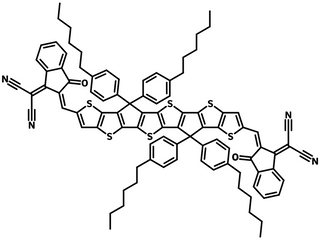6TIC, NFA with enhanced planarity for efficient molecular packing and charge transport
Strong inter charge transfer and able to achieve a high power conversion efficiency of 14.24%
Specifications | Pricing and Options | MSDS | Literature and Reviews
6TIC (CAS number 2244414-53-5), also known as IXIC, has an acceptor–donor–acceptor (A–D–A) structure consisting of an electron-rich fused terthieno[3,2-b]thiophene core and two electron withdrawing 1,1-dicyanomethylene-3-indanone (IC) peripheral units.
With two outward thieno[3,2-b]thiophene units, 6TIC has enhanced planarity while comparing with 4TIC (IHIC), leading to more efficient molecular packing and charge transport. 6TIC thin film shows an intense and broadened absorption between 600 and 900 nm with an onset at ~905 nm.
Furthermore, 6TIC shows superior electron mobility than that of 4TIC for its longer effective conjugation length and stronger inter charge transfer (ICT) than 4TIC. 6TIC also has a higher lying HOMO energy level and a slightly smaller bandgap.
Ternary polymer solar cell fabricated by using PBTA-PS as donor, and LA1 and 6TIC as binary acceptors achieved a PCE of 14.24% due to a well-matched complementary absorption profiles and co-crystallization properties.
High efficient non-fullerene acceptor
with highly conjugated core
Efficient charge transport
Enhanced molecular planarity and packing
Worldwide shipping
Quick and reliable shipping
High purity
>98% High purity
Device structure: ITO/PEDTO:PSS/PBTA-PS:LA1:6TIC/PDINO/Al[5]
| Thickness (nm) | VOC(V) | JSC(mA cm-2) | FF (%) | PCE(%) |
| 100 nm | 0.84 | 22.33 | 75.94 | 14.24 |
Chemical Structure

General Information
| CAS Number | 2244414-53-5 |
| Chemical Formula | C94H80N4O2S6 |
| Purity | ≥98% (1HNMR) |
| Full Name | 2,2'- [[6,6,12,12-tetrakis(4-hexylphenyl)-6,12-dihydro-Thieno[2'',3'':4',5']thieno[3',2':4,5]cyclopenta[1,2-b]thieno[2''',3''':4'',5'']thieno[2'',3'':3',4']cyclopenta[1',2':4,5]thieno[2,3-d]thiophene-2,7-diyl]bis[methylidyne(3-oxo1H-indene-2,1(3H)-diylidene) ]]bis-propanedinitrile |
| Molecular Weight | 1490.06 g/mol |
| Absorption | λmax 718 nm, 795 nm (Film) |
| HOMO / LUMO | HOMO = -5.45 eV, LUMO = -3.94 eV [1] |
| Solubility | Chloroform, chlorobezene |
| Form | Dark blue powder/crystals |
| Synonyms | IXIC |
| Classification / Family | NFAs, n-type non-fullerene electron acceptors, Organic semiconducting materials, Low band-gap small molecule, Small molecular acceptor, Organic photovoltaics, Polymer solar cells, NF-PSCs. |
Pricing
| Batch | Quantity | Price |
| M2329A1 | 100 mg | £270 |
| M2329A1 | 250 mg | £540 |
| M2329A1 | 500 mg | £960 |
| M2329A1 | 1 g | £1770 |
MSDS Documentation
Literature and Reviews.
- Mapping Non-Fullerene Acceptors with a Novel Wide Bandgap Polymer for High Performance Polymer Solar Cells, X. Liao et al., Adv. Energy Mater., 8 (24), 1801214 (2018); DOI:10.1002/aenm.201801214.
- Modulation of End Groups for Low-Bandgap Nonfullerene Acceptors Enabling High-Performance Organic Solar Cells, Y. Chen et al., Adv. Energy Mater., 8 (27), 1801203 (2018); DOI: 10.1002/aenm.201801203.
- Terthieno[3,2-b]thiophene (6T) based low band-gap fused-ring electron acceptor for high efficiency solar cell with a high short-circuit current density and low open-circuit voltage loss, X. Shi et al., Adv. Energy Mater., 8 (12), 1702831 (2017); DOI: 10.1002/aenm.201702831.
Related Products
Semiconducting polymers for bulk heterojunction, OPV, OLED, OFET and perovskite interfaces and solar cell research.


